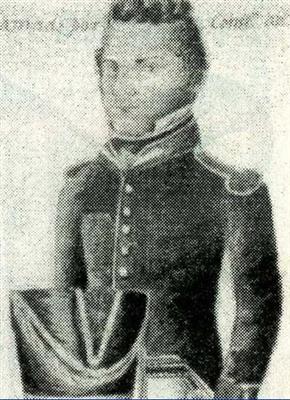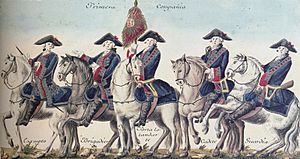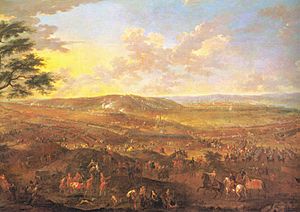Antonio de Benavides facts for kids
Quick facts for kids
Antonio de Benavides
|
|
|---|---|
 |
|
| 34th Royal Governor of La Florida | |
| In office 3 August 1718 – 21 May 1734 |
|
| Preceded by | Juan de Ayala y Escobar |
| Succeeded by | Francisco del Moral y Sánchez |
| Governor of Veracruz | |
| In office 1734–1745 |
|
| Governor of Yucatán | |
| In office 1745–1750 |
|
| Preceded by | Manuel Salcedo |
| Succeeded by | Juan José de Clou |
| Personal details | |
| Born | 8 December, 1678 La Matanza de Acentejo, Tenerife, Canary Islands, Spain |
| Died | 9 January 1762 (aged 83) Tenerife, Canary Islands, Spain |
| Profession | General and Administrator (governor of Florida, Veracruz and Yucatán) |
Antonio Benavides Bazán y Molina (December 8, 1678 – January 9, 1762) was a Lieutenant General in the Spanish Army. He held important jobs in the Americas. He was the Royal Governor of Spanish Florida from 1718 to 1734. He also governed Veracruz (1734–1745) and Yucatán (1745–1750). Later, he was Governor of Manila in the Philippines.
Before these roles, he was a brave soldier in the War of the Spanish Succession around 1710. He might have even saved the life of Philip V, the first Bourbon King of Spain.
While in Florida, Benavides investigated the previous governor for illegal trading. He also stopped several attempts by the English to invade Florida. He made friends with local Indian groups. These groups had not been friendly to the Spanish before. He also helped protect the rights of indigenous people. Benavides created the first black militia unit in Florida. This unit helped defend St. Augustine from British attacks. It seems Benavides gave most of his money to help poor people in Florida, Yucatan, Veracruz, and the Canary Islands.
Contents
Antonio de Benavides was born on December 8, 1678. His birthplace was La Matanza de Acentejo, Tenerife, in the Canary Islands, which are part of Spain. His family were farmers. His father, Andrés Benavides, was a captain in the local army. Antonio was the third of eight children.
In 1698, a captain from Havana stayed at the Benavides family home. He was looking for young men to join the Spanish army in the New World. The officer saw that young Antonio had military potential. He asked Antonio's parents if he could join as a cadet. In 1699, at age 19, Benavides joined the Spanish army. He went to Havana, Cuba, and became a second lieutenant in 1701.
When the War of the Spanish Succession began in 1701, Benavides went to Madrid. He was part of a dragoon regiment sent to help King Philip V. The king heard about Benavides' skill as a sharpshooter. He invited Benavides to go hunting with him. They often hunted together and became friends.
The king usually hunted with the best shooters from his Royal Guard Corps. This group provided his personal security. Benavides was so skilled and had become friends with the king. So, the king ordered him to join the Corps. This was unusual because normally only children of noble families could join. Benavides joined the second company, which was a very important part of the Royal Army. He showed great bravery in battles in Flanders and at the Battle of Saragossa.
War of the Spanish Succession
In 1710, Benavides fought in several battles during the War of the Spanish Succession (1701–1714). On August 20, 1710, he led a cavalry group in the Battle of Saragossa. His group managed to capture the enemy's cannons in a surprise attack. However, his side suffered many losses and had to retreat.
Benavides may have saved King Philip V's life on September 10, 1710. This happened during the Battle of Villaviciosa near Guadalajara. The king was on his white horse and exposed to enemy fire. He did not have another horse to escape. Benavides offered his own horse to the king, who accepted. A cannonball hit Benavides, knocking him unconscious. The king noticed he was missing and ordered his men to find him. Benavides was found and treated by the king's doctors.
To reward his bravery, the king made Benavides a colonel. After this, the king often called him "Father" as a sign of respect. After the war ended with the Treaty of Utrecht, Benavides was seen as an excellent cavalry officer. In 1714, he was promoted to brigadier of cavalry in the Royal Guard Corps.
Administration in Florida
Arrival in Florida
King Philip V wanted to use Benavides' skills and reward his loyalty. So, he made Benavides governor and captain general of Florida. At the time, there were problems in St. Augustine, the capital of La Florida. The job was known to be difficult and dangerous. Benavides was sworn into office quickly so he could start his work right away. He sailed from Tenerife to Florida.
Early Years as Governor (1718–1721)
The borders of Spain's Florida province were being challenged by other European powers. The British had founded Charles Town in 1670. This was on land that Spain claimed. The British and their Creek Indian allies often attacked Spanish missions. These attacks destroyed most of the Spanish missions in Florida.
The previous governor, Juan de Ayala y Escobar, had faced many attacks from these tribes and the British. The Spanish Crown needed a strong leader to take over. Benavides, with his military background and the king's support, was chosen. When Benavides arrived in St. Augustine in late 1718, he investigated the previous governor. He accused Ayala of illegal trading with British merchants. Ayala was arrested and sent away.
Benavides quickly learned about the area. He visited the six Native American settlements around the city. He chose skilled people to help him in his government. He regularly sent reports to the king, explaining the colony's situation and what changes were needed. The king approved his plans, and he continued as governor.
Protecting Florida
The Spanish had left Mission San Luis de Apalachee in 1704 to stop the British from taking it. They did not return until 1718. Benavides sent Captain Joseph Primo de Rivera to build a stronger fort near the coast. This new fort was at San Marcos de Apalachee. It was built to defend against attackers.
In 1719, France declared war on Spain. Pensacola was captured by French forces from French Louisiana. The French occupied Pensacola for a short time. Later, Spanish forces took it back, but then the French took it again. Pensacola was officially returned to Spanish control in 1722.
Also in 1719, Governor Benavides started building new defenses in St. Augustine. These defenses, called the Cubo Line, were finished in 1721. They helped protect the city from attacks.
Later Years Governing Florida (1721–1734)
In 1721, Benavides looked into Spain's claims to the coast of what is now Georgia. In 1724, he asked the Spanish Crown to send money for Florida by land instead of by sea. He thought a land route would avoid delays caused by a lack of ships. He also suggested building forts along the Gulf Coast to protect this land route. However, this idea was not approved.
In 1726, Benavides had to go to Havana for surgery. Ignacio Rodriguez Rozo took his place as governor for a short time. After returning to Florida, Benavides formed a militia of black slaves. This group helped defend St. Augustine from attacks. He appointed Francisco Menéndez, a runaway slave from South Carolina, as its captain. Menéndez had fought alongside the Yamasee Indians against European settlers.
Runaway slaves from the Carolinas continued to seek safety in Florida. They knew they had more rights under the Spanish system of slavery. In 1733, the Spanish government in Madrid made a new rule. It banned the sale of runaway slaves. It also freed black soldiers after four years of service to the crown. Benavides then said that runaways who became Catholic and worked for four years in St. Augustine would be freed.
Francisco Menéndez and other slaves finally gained full freedom in 1738. This was thanks to a decree from the new governor of Florida, Manuel de Montiano. During his time as governor of Florida, Benavides successfully defended against British attacks. He also stopped piracy in Florida waters. Before he left Florida, the king promoted him to Field Marshal. Benavides also gave his belongings to the needy people of Florida.
Governor of Veracruz
On March 27, 1733, the king appointed Benavides governor of Veracruz province in Mexico. The people of Florida were sad to see him go. Benavides continued his policies in Veracruz. He also kept up his charity, giving much of his money to the poor people there.
Benavides was very interested in improving the defenses of Veracruz. In just five months, he expanded the forts and built a large water tank. He also increased the number of soldiers.
Governor of Yucatan
Benavides became Governor of Yucatán when war with England started again. He was now a Lieutenant General in the Royal Armies. He led a group to defend the coasts of Tabasco and Honduras during the War of Jenkins' Ear (1739–48). He commanded soldiers and local militia to protect these coasts and ports. The war ended with a peace treaty in 1748. Benavides continued his efforts to stop pirates and privateers who attacked Spanish ships.
Governor Benavides suggested creating a fund to pay soldiers in Campeche better. This fund would use money from vacant encomiendas (land grants that included the right to labor from local people). This idea made the wealthy families who benefited from encomiendas very upset. Benavides had to withdraw his plan. He also withdrew a plan to create a government monopoly on salt production. This plan would have affected everyone, so it was also very unpopular.
In 1748, a royal decree was issued. It told governors to stop the production and use of aguardiente de cana, a local brandy. This was because Spanish companies that sold spirits were losing money. Benavides also had a disagreement with the council of Campeche. This was about his use of Indian labor in rice fields and for cutting valuable timber. Antonio Benavides' time in Yucatan ended in 1750. He was then appointed governor of Manila in the Philippines.
Last Years
In 1750, Benavides sailed from Yucatan to Veracruz, then to Acapulco, and on to the Philippines. When he finally returned to Tenerife at age 70, he was offered the job of captain general of the Canary Islands. He turned it down, saying he was too old and unwell. He gave money to expand and improve the Nuestra Señora de Los Desamparados hospital in Santa Cruz de Tenerife for the poor. He retired there himself in January 1761 and died on January 9, 1762. His remains are in the "Parroquia de la Conception" church.
Personal Life
Benavides never married. While he lived in the Americas, he bought an African slave named Antonio Quijada. Quijada returned with Benavides to the Canary Islands and stayed with him until Benavides died.
Legacy
- On January 9, 2012, the city council of Tenerife honored Benavides. This was to mark 250 years since his death. A wreath was placed at his newly restored gravestone. This is in the Church of the Conception (Iglesia de la Concepción) in Santa Cruz de Tenerife, where he was buried. The inscription on his headstone reads: Aquí yace el Excmo. Sr. D. Antonio Benavides, teniente general de los Reales Ejércitos, natural de esta isla de Tenerife. Varón de tanta virtud, cuanto cabe por arte y naturaleza en la condición mortal ("Here lies the Honorable Antonio Benavides, Lieutenant General of the Royal Armies, a native of the island of Tenerife. A man of such virtue, as should be for art and nature in the mortal condition").
- The novel La cruz de plata (The Silver Cross) is based on the adventures of Antonio de Benavides. It was published by Jesús Villanueva Jiménez in 2015.
See also
 In Spanish: Antonio Benavides Bazán y Molina para niños
In Spanish: Antonio Benavides Bazán y Molina para niños



